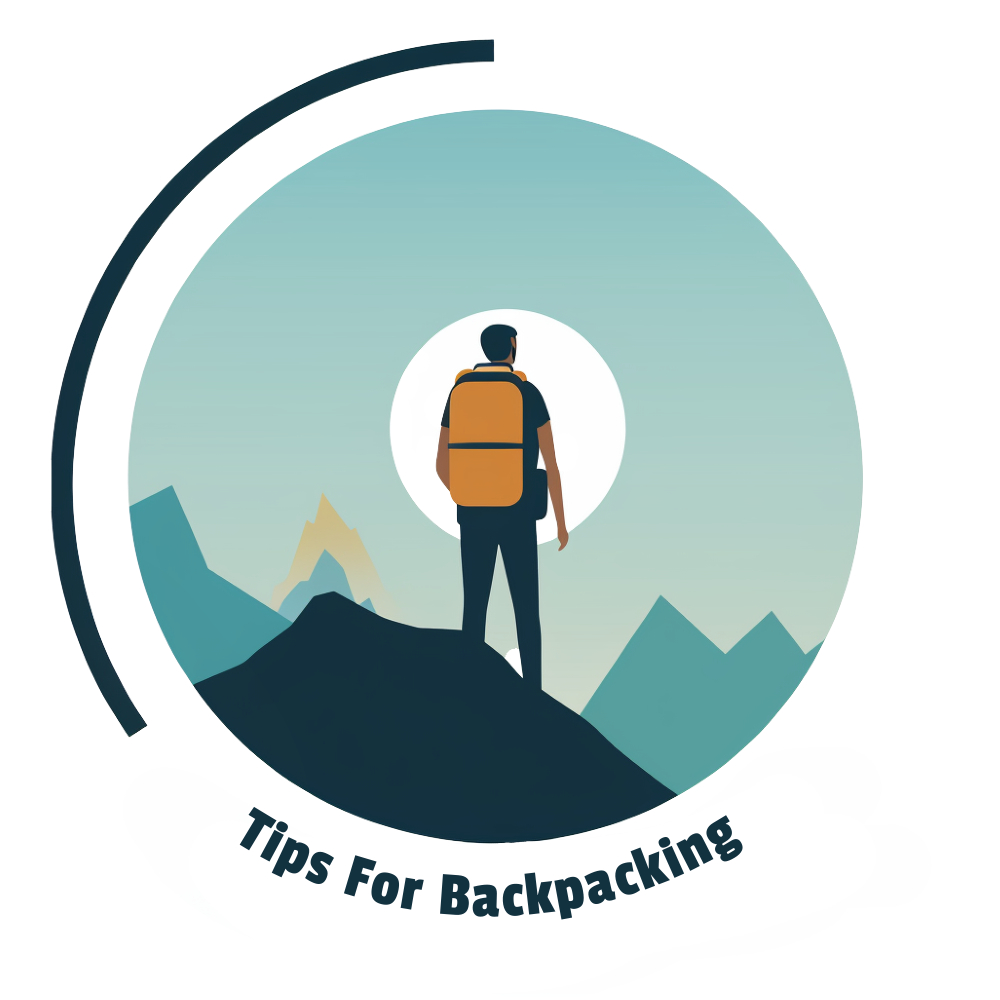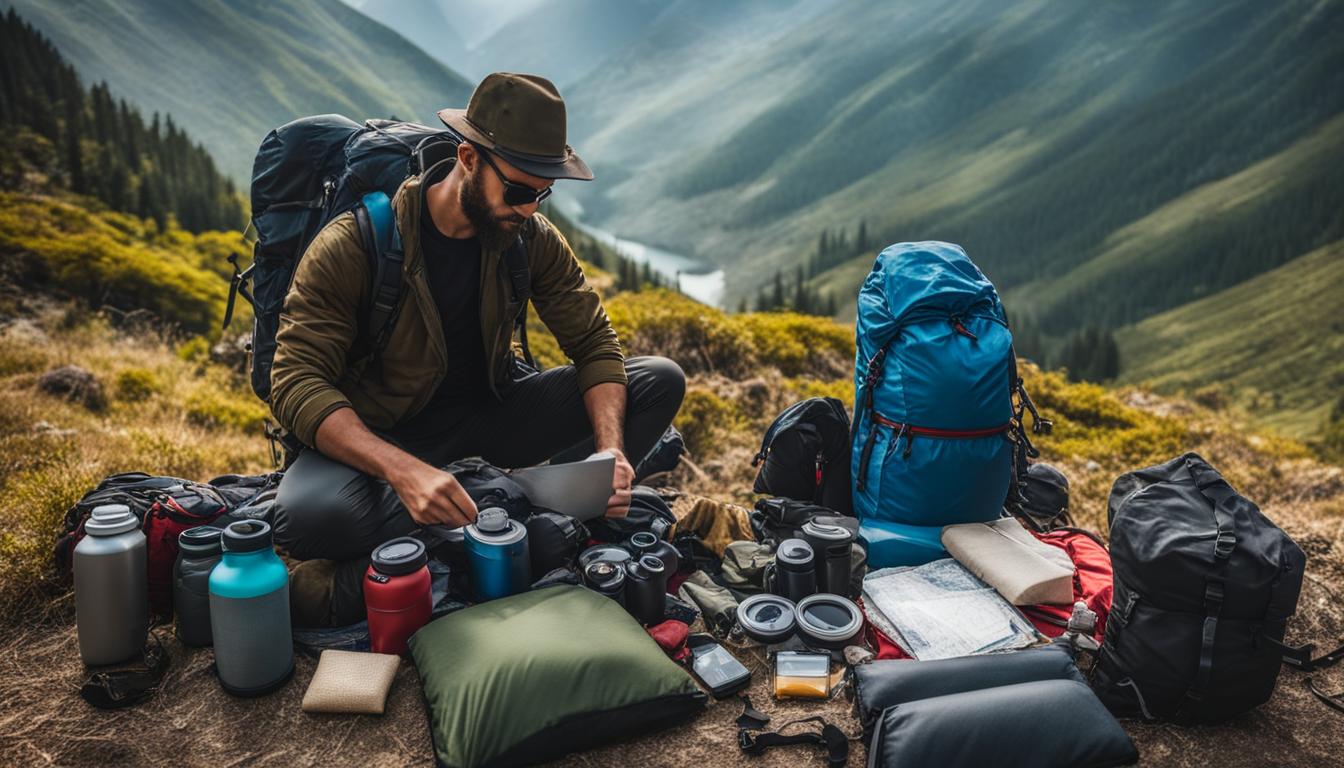Are you planning your first backpacking trip? Or maybe you’re a seasoned backpacker looking for a comprehensive checklist to ensure you have all the essential items for your next adventure? Look no further! In this article, I will provide you with a detailed backpacking checklist that covers everything you need, from shelter and backpacking gear to food and personal items.
Being well-prepared is key to having a successful and enjoyable backpacking experience. With the right gear and equipment, you can navigate through the wilderness with confidence. Whether you’re a beginner or an experienced backpacker, this checklist will help you pack everything you need for your trip.
Key Takeaways:
- Include essential items for beginners in your backpacking checklist.
- Cover a wide range of categories including shelter, backpack and storage, camp kitchen, entertainment, navigation equipment, first aid, personal toiletries, and food.
- Ensure you have a reliable backpacking tent or shelter, a comfortable backpack with enough storage space, and additional storage items like trash compactor bags and waterproof stuff sacks.
- Pack lightweight cooking equipment for your camp kitchen, including a stove, cookpot, cup/mug, small quick-dry towel, biodegradable soap, and a spice kit.
- Bring entertainment items like a book, crossword puzzles, or games, as well as navigation equipment like a compass, GPS phone app, and topo maps.
Now that you have the ultimate backpacking checklist, you can feel confident that you have everything you need for your upcoming trip. Happy backpacking!
Shelter and Backpack & Storage
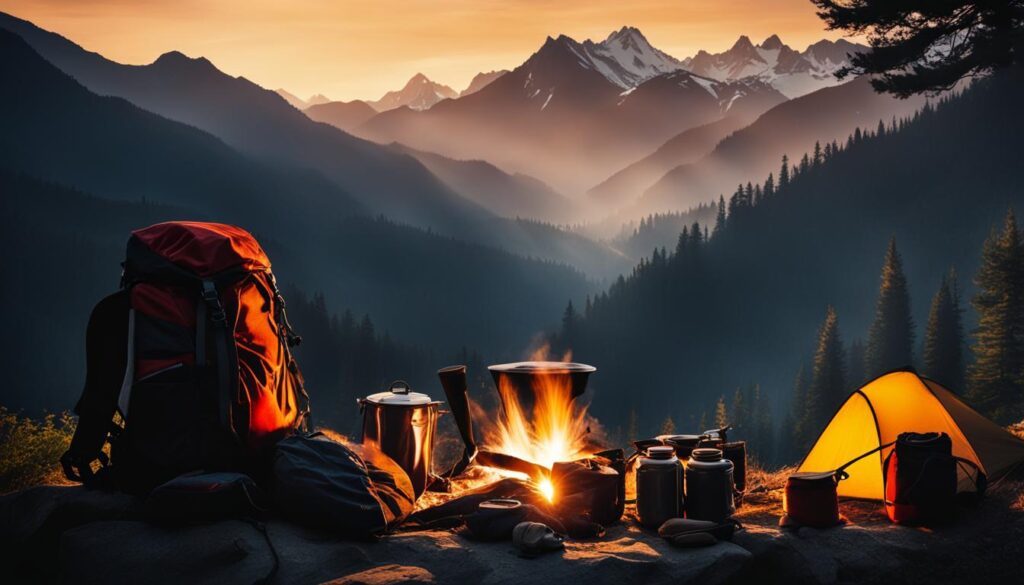
When it comes to backpacking, having the right shelter and backpacking gear is crucial for a successful trip. Your shelter should provide protection from the elements and be lightweight and easy to set up. A reliable backpack is also essential for carrying all your gear comfortably.
One important item to consider for storage is a trash compactor bag. This sturdy bag helps keep your gear dry and organized, preventing any leaks or spills from ruining your equipment. Waterproof stuff sacks are also a great investment to keep your clothes and other essentials dry in wet conditions. And don’t forget about large Ziploc bags for storing food and keeping it fresh.
For shorter excursions from your main campsite, a summit pack comes in handy. This smaller backpack allows you to carry just the essentials for a day hike, keeping your main backpack at the campsite. It’s lightweight and compact, making it easy to take with you on your adventures.
Having the right shelter and backpacking storage options ensures that you’re prepared for whatever nature throws at you. So remember to pack a reliable tent or shelter, a comfortable backpack, and storage solutions like trash compactor bags, waterproof stuff sacks, large Ziploc bags, and a summit pack for day hikes.
| Shelter and Backpack & Storage Checklist: |
|---|
| Shelter (tent or shelter system) |
| Backpack (comfortable and spacious) |
| Trash compactor bag (for gear storage) |
| Waterproof stuff sacks (for keeping gear dry) |
| Large Ziploc bags (for food storage) |
| Summit pack (for day hikes) |
With the right shelter and backpacking gear, you’ll be well-equipped to tackle the challenges of the wilderness. So make sure to consider these items when planning your next backpacking trip.
Camp Kitchen
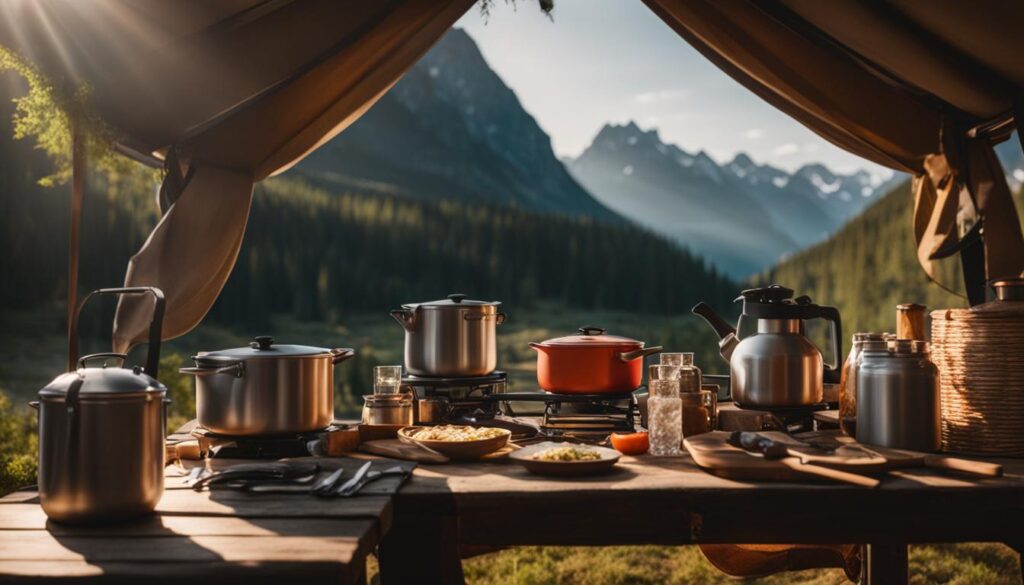
When it comes to cooking meals during a backpacking trip, having the right camp kitchen essentials is key. Here are some must-have items for your backpacking checklist:
- Stove: A lightweight stove is essential for cooking food in the wilderness. Look for compact and fuel-efficient options that are easy to use.
- Cookpot: Invest in a cookpot that is durable and lightweight. Look for one with a lid to help retain heat while cooking.
- Cup/mug: Bring a cup or mug that is lightweight and durable. Look for options that are designed for outdoor use.
- Small quick-dry towel: Pack a small towel that dries quickly for cleaning dishes and utensils.
- Biodegradable soap: Use biodegradable soap for washing dishes and utensils. This is important to minimize environmental impact.
- Spice kit: Add flavor to your meals by bringing a small spice kit with your favorite spices and seasonings.
By including these camp kitchen essentials in your backpacking checklist, you’ll be well-prepared to cook delicious meals and enjoy your outdoor adventure.
Entertainment and Navigation Equipment
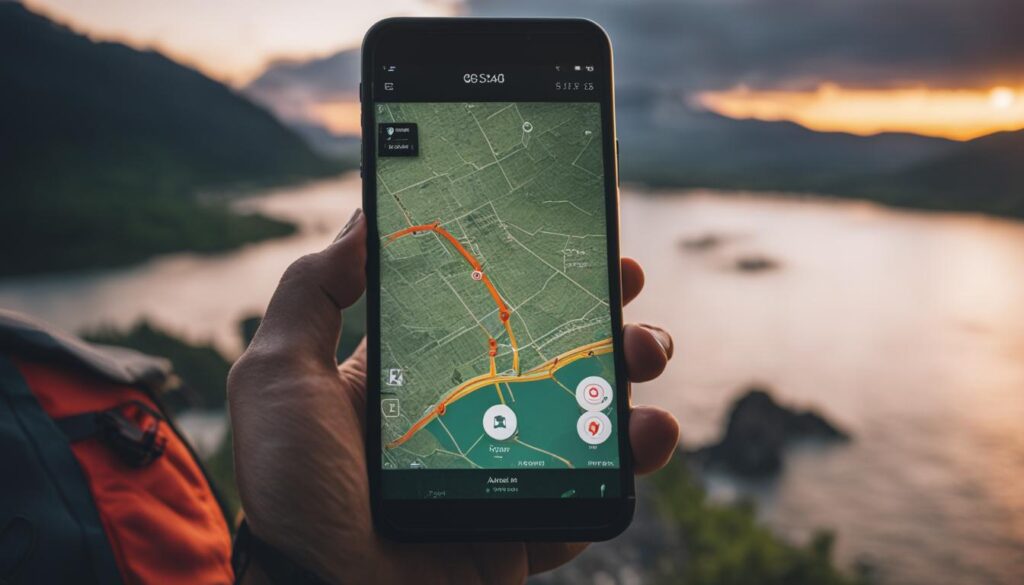
When I’m out in the wilderness, I like to have some form of entertainment to unwind and pass the time during downtime. One of my go-to options is bringing a good book or my Kindle. It’s a great way to escape into another world while enjoying the serenity of nature. Plus, reading can be a relaxing and immersive experience that helps me disconnect from the noise of everyday life.
“Books are the plane, and the train, and the road. They are the destination, and the journey. They are home.” – Anna Quindlen
For those who prefer brain teasers, crossword puzzles are a fantastic choice. They keep my mind sharp and entertained while I soak in the beauty of the surroundings. It’s like a mental workout amidst the natural wonders.
When it comes to navigation, having the right tools is crucial to stay on track and avoid getting lost. A compass is an essential piece of equipment that helps me navigate through the wilderness. It provides a sense of direction and ensures I’m heading in the right path.
Navigating with Technology
While traditional methods like compasses are reliable, the advancement of technology has also made navigation easier. I utilize a GPS phone app to have access to accurate maps and real-time location tracking. It provides an additional layer of confidence and peace of mind, especially when exploring unfamiliar terrains.
Whether I choose to lose myself in a captivating book, challenge my mind with crossword puzzles, or rely on modern technology for navigation, having various forms of entertainment enhances the backpacking experience. It allows me to create a perfect balance between enjoying the beauty of nature and finding solace in the world of words and puzzles.
First Aid and Personal Toiletries
When venturing into the wilderness, it is crucial to prioritize safety and hygiene. Packing a well-stocked first aid kit is essential for addressing minor injuries and illnesses that may occur during a backpacking trip. Having items like band-aids, antibiotic ointment, gauze pads, and tweezers can help treat small wounds and prevent infection. It’s always better to be prepared.
Personal toiletries are also important for maintaining cleanliness and comfort while on the trail. Items like a toothbrush, toothpaste, and toilet paper or wipes are necessary for proper hygiene. Being mindful of personal cleanliness not only promotes physical well-being but also contributes to overall enjoyment of the backpacking experience.
Remember, the wilderness can be unpredictable, so it’s essential to be prepared for any situation. By including first aid supplies and personal toiletries in your backpacking checklist, you are taking proactive steps to ensure your safety and well-being throughout your adventure. It’s always better to have these items readily available and not need them, than to find yourself in a situation where you do.
Table: Essential First Aid and Personal Toiletries
| First Aid | Personal Toiletries |
|---|---|
| Band-aids | Toothbrush |
| Antibiotic ointment | Toothpaste |
| Gauze pads | Toilet paper/wipes |
Remember, safety and hygiene should never be compromised when backpacking in the wilderness. Packing a well-stocked first aid kit and personal toiletries ensures that you are prepared for any unexpected situations and can fully enjoy your backpacking adventure.
By prioritizing your health and well-being, you’ll be able to fully immerse yourself in the beauty of nature. Take a moment to review your backpacking checklist and ensure you have all the necessary first aid supplies and personal toiletries for a safe and enjoyable trip. Happy backpacking!
Food
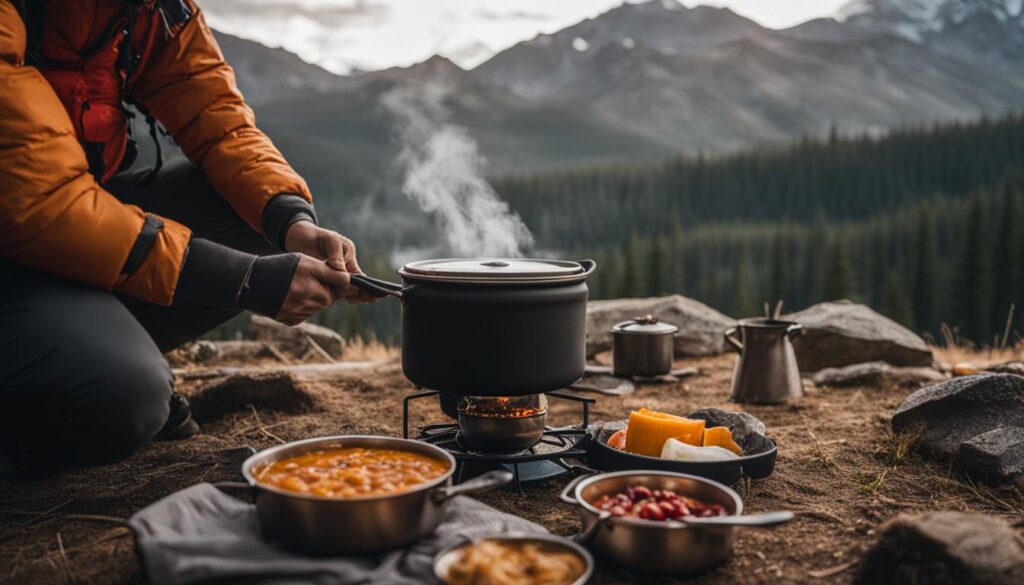
When it comes to backpacking, proper provisions are essential to keep you fueled and energized throughout your trip. Packing the right amount of food is crucial, and it’s always a good idea to have an extra day’s supply as a safety net. Here are some key considerations for your backpacking food:
- Provisions: Choose lightweight, non-perishable foods that are high in calories and nutrients. Opt for dehydrated meals, energy bars, nuts, dried fruits, and jerky.
- Extra day’s supply of food: In case of unexpected delays or emergencies, having an extra day’s worth of food can provide peace of mind. Pack items that have a long shelf life and require minimal preparation.
- Food bag/Ursack: Proper food storage is important to prevent wildlife encounters. Use a dedicated food bag or Ursack to hang your provisions away from your campsite, reducing the risk of attracting animals.
- Water treatment: Staying hydrated is crucial in the wilderness. Carry an effective water treatment method such as a water filter, purification tablets, or a UV sterilizer to ensure access to clean drinking water.
Remember to consider your dietary restrictions, personal preferences, and any potential food allergies when selecting your backpacking food. Pack a variety of options to keep your meals interesting and enjoyable during your adventure. Now, let’s take a closer look at a table summarizing the key points of backpacking food:
| Considerations | Details |
|---|---|
| Provisions | Choose lightweight, non-perishable foods high in calories and nutrients, such as dehydrated meals, energy bars, nuts, dried fruits, and jerky. |
| Extra day’s supply of food | Pack an additional day’s worth of food to account for unexpected delays or emergencies. Select items with a long shelf life and minimal preparation requirements. |
| Food bag/Ursack | Use a dedicated food bag or Ursack to store and hang your provisions away from your campsite, minimizing the risk of attracting wildlife. |
| Water treatment | Carry a reliable water treatment method such as a water filter, purification tablets, or a UV sterilizer to ensure access to clean drinking water. |
By carefully planning and packing your backpacking food, you can fuel your body for the adventure ahead while minimizing the risk of wildlife encounters and ensuring proper hydration. Now that we’ve covered the essentials of food, it’s time to move on to the next section of our comprehensive backpacking checklist.
Conclusion
So, there you have it – the ultimate guide on how to create the perfect backpacking checklist! Whether you’re a beginner or an experienced backpacker, this checklist covers all the essential items you’ll need for a successful trip in the wilderness.
By following this comprehensive checklist, you can ensure that you have everything you need, from your shelter and backpacking gear to your food and personal items. It’s important to be well-prepared and have the right equipment to make your adventure safe and enjoyable.
Remember to consider all the categories, including shelter, backpack, camp kitchen, entertainment, navigation equipment, first aid, personal toiletries, and food. Each category plays a crucial role in ensuring you have a smooth journey.
So, before you embark on your next backpacking trip, take the time to create your checklist using these guidelines. Being well-prepared will give you peace of mind and allow you to fully immerse yourself in the beauty of the great outdoors. Happy backpacking!
Are There Any Specific Items I Should Add to My Backpacking Checklist for Spring?
When preparing for spring backpacking, it’s crucial to have a comprehensive spring backpacking essentials checklist. Some specific items to include are a lightweight tent, sleeping bag suitable for cool temperatures, waterproof clothing, a compact stove, and a reliable water filtration system. These essentials will help ensure a safe and enjoyable backpacking trip.
FAQ
What should be included in a comprehensive backpacking checklist for beginners?
Essential items to include in your backpacking checklist are shelter, backpack, storage options, camp kitchen equipment, entertainment items, navigation equipment, first aid kit, personal toiletries, and enough food and water.
What should I look for in a backpacking tent or shelter?
The shelter should be reliable and able to protect you from the elements. Look for a lightweight and durable backpacking tent that is easy to set up and pack away.
What kind of backpack should I bring for a backpacking trip?
Choose a backpack that is comfortable to carry and has enough storage space for all your necessary items. Consider features like adjustable straps, a padded hip belt, and multiple compartments for organization.
What are some storage options I should consider for backpacking?
Trash compactor bags, waterproof stuff sacks, and large Ziploc bags are great options for keeping your gear dry and organized. Summit packs are also useful for day hikes or shorter excursions from the main campsite.
What kind of kitchen equipment should I pack for backpacking?
Essential camp kitchen items include a lightweight stove and fuel, a cookpot and lid for cooking food, a cup/mug, a small quick-dry towel for cleaning dishes, biodegradable soap for washing utensils, and a spice kit for adding flavor to meals.
What can I do for entertainment during backpacking downtime?
Bring a book or a Kindle, crossword puzzles, or games like cribbage or dice for entertainment during downtime in the wilderness.
What navigation equipment should I bring for backpacking?
It is important to have a compass, topo maps, a GPS phone app, and a satellite messenger or PLB for remote locations to help you stay on track during your trip.
What should be included in a first aid kit for backpacking?
Important items to include in a well-stocked first aid kit are band-aids, antibiotic ointment, gauze pads, tweezers, and any necessary medications.
What personal toiletries should I bring for backpacking?
Personal toiletry items that you should pack include a toothbrush, toothpaste, and toilet paper or wipes for hygiene purposes.
How much food should I pack for a backpacking trip?
Pack between 2,500-3,500 calories worth of food per day. It is also important to have an extra day’s supply of food for emergencies.
How should I pack and protect my food during backpacking?
Pack your food in a food bag or Ursack for protection from animals. It is also crucial to have water treatment options to ensure access to clean drinking water.
How can I create the perfect backpacking checklist?
By following this comprehensive backpacking checklist, you can ensure you have everything you need for your trip, from shelter and backpacking gear to food and personal items. Consider all necessary gear and equipment to have a safe and enjoyable wilderness adventure.
